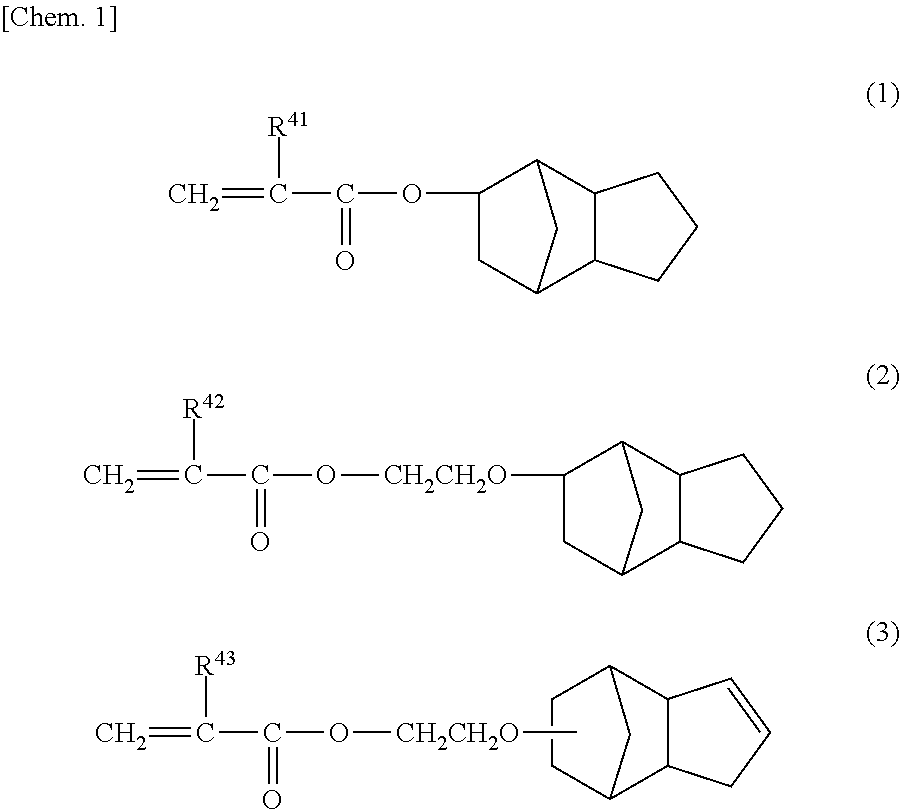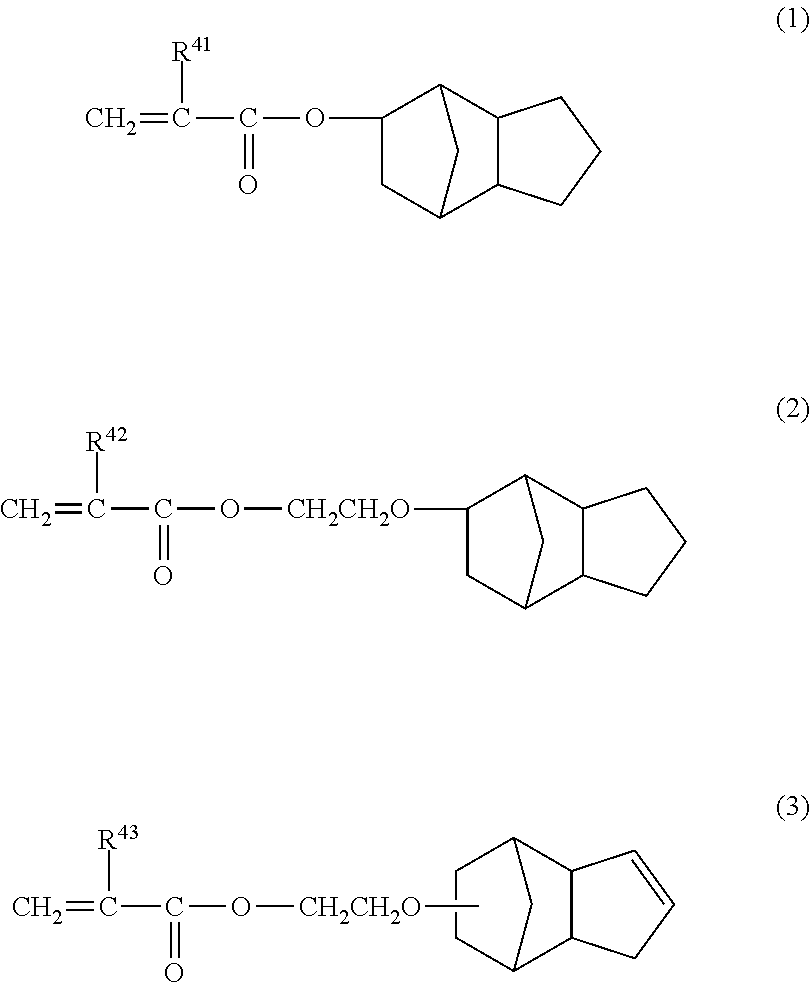Curable composition for nanoimprinting and cured product
a technology of nano-imprinting and composition, which is applied in the direction of decorative surface effects, electrical appliances, and nanoinformatics, can solve the problems of line edge roughness, cost explosion, and inability to cure, and achieve satisfactory mold releasability of a cured product, sufficient curability, and excellent transferability
- Summary
- Abstract
- Description
- Claims
- Application Information
AI Technical Summary
Benefits of technology
Problems solved by technology
Method used
Image
Examples
preparation example 1
Synthesis of Polymer (A-1)
[0061]Cyclohexanone (125 g) was fed into a 1-liter separable flask equipped with a stirrer, a thermometer, a reflux condenser, dropping funnels, and a nitrogen inlet tube, and heated to 95° C., to which 150 g of dicyclopentanyl methacrylate (“FA-513M” supplied by Hitachi Chemical. Co., Ltd.), 6 g of 2,2′-azobis(2-methylbutyronitrile) (“ABN-E” supplied by Japan Hydrazine Co., Inc. (now Japan Finechem Company, Inc.)), and 212 g of cyclohexanone were added dropwise together over 3 hours. After the dropwise addition, the mixture was aged for 4 hours and thereby yielded a target Polymer (A-1). The resulting polymer had a glass transition temperature Tg of 175° C.
preparation example 2
Synthesis of Polymer (A-2)
[0062]Cyclohexanone (125 g) was fed into a 1-liter separable flask equipped with a stirrer, a thermometer, a reflux condenser, dropping funnels, and a nitrogen inlet tube and heated to 95° C., to which 138 g of dicyclopentanyl methacrylate (“FA-513M” supplied by Hitachi Chemical Co., Ltd.), 12.2 g of methacrylic acid, 4 g of 2,2′-azobis(2-methylbutyronitrile) (“ABN-E” supplied by Japan Hydrazine Co., Inc. (now Japan Finechem Company, Inc.)), and 212 g of cyclohexanone were added dropwise together over 3 hours. After the dropwise addition, the mixture was aged for 4 hours and thereby yielded a target Polymer (A-2). The resulting polymer had a glass transition temperature Tg of 140° C. and an acid value (acid number) of 60 KOH-mg / g.
preparation example 3
Synthesis of Polymer (A-3)
[0063]Propylene glycol monomethyl ether (“MMPG” supplied by Daicel Chemical Industries, Ltd.) (300 g) was fed into a 2-liter separable flask equipped with a stirrer, a thermometer, a reflux condenser, dropping funnels, and a nitrogen inlet tube, and heated to 110° C., to which 151 g of methacrylic acid, 110 g of methyl methacrylate, 200 g of MMPG, and 28.7 g of t-butyl peroxy-2-ethylhexanoate (“PERBUTYL O” supplied by NOF Corporation) were added dropwise together over 3 hours. After the dropwise addition, the mixture was aged for 4 hours and thereby synthetically yielded a trunk polymer containing carboxyl groups. Next, the trunk polymer solution was combined with 239 g of 3,4-epoxycyclohexylmethyl acrylate (“CYCLOMER A200” supplied by Daicel Chemical Industries, Ltd.), 2.4 g of triphenylphosphine, and 1.0 g of methylhydroquinone, followed by a reaction at 100° C. for 10 hours. The reaction was performed in an atmosphere of mixture of air and nitrogen. This...
PUM
| Property | Measurement | Unit |
|---|---|---|
| glass transition temperature | aaaaa | aaaaa |
| width | aaaaa | aaaaa |
| thickness | aaaaa | aaaaa |
Abstract
Description
Claims
Application Information
 Login to View More
Login to View More - R&D
- Intellectual Property
- Life Sciences
- Materials
- Tech Scout
- Unparalleled Data Quality
- Higher Quality Content
- 60% Fewer Hallucinations
Browse by: Latest US Patents, China's latest patents, Technical Efficacy Thesaurus, Application Domain, Technology Topic, Popular Technical Reports.
© 2025 PatSnap. All rights reserved.Legal|Privacy policy|Modern Slavery Act Transparency Statement|Sitemap|About US| Contact US: help@patsnap.com


